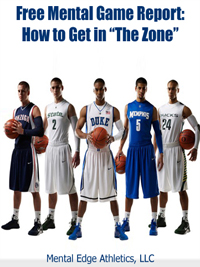There are many different types of motivation and reinforcements a coach can use; some may increase or decrease motivation and team cohesion, which has a huge effect on athletic performance. Behavior Alteration Techniques (BAT’s) are some motivational techniques that Martin, Matthew M., Rocca, Kelly A., Cayanus, Jacob L., & Weber, Keith (2009) elaborate on. Their research defines BATs as techniques and messages that teachers used to control their classroom students and classroom environment; they noted that there are 22 different BATs. Some of these techniques are classified as positive BATs and negative BATs. Positive BATs had a positive relationship to motivation and negative BATs had a negative relationship to motivation.
Some examples of negative BATs that Martin et al. (2009) measured in their study include Punishment from Behavior, Punishment from Others, Guilt, Debt and Negative Relationship. Examples of positive BATs are Immediate Reward from Behavior, Self-Esteem, and Reward from Others, Altruism and Positive Relationship. Coaching and motivating has much to do with what is said to athletes and teams, with this in mind what would these BATs sound like to an athlete?
An example of Punishment from Behavior would be if a coach said “if you do not listen to what I say then you will not be successful or win.” The coach firmly states the punishment if the athlete does not comply with their instruction. Punishment from Others would be if the athlete does not do what the coach says, the team will not accept them as a player. The obvious punishment is not from the coach, but from the athletes themselves. The coach uses the team against the athlete to have them do what they want, and in doing so makes the team into a negative aspect of the sport. Guilt is another negative BAT that is used often by coaches of every level, in this technique the coach has an athlete know that if they do not perform to the coach’s expectation or time limit, if the athlete fails, the whole team suffers the consequences along with that particular athlete. In doing so the coach produces guilt for the athlete that does not perform to the coach’s expectation.
A Negative Relationship coach would tell an athlete or team if they do not listen to them or if they lose a contest, the coach will state that the coach has lost respect for them or does not believe in the team or athlete. The coach establishes a negative relationship between him/her and the team.
When a coach utilizes positive BATs, for example Immediate Reward from Behavior, a coach would explain to their team or individual athletes that going through certain drills and team building exercises will not only improve their skills but also be a fun experience for them. The immediate reward in this scenario is the fun experienced by the team and athletes; emphasizing the fun factor for young athletes (elementary ages through high school) is crucial for participation motivation, and a positive increase in overall athletic performance. Barker (2002) reinforces the concept of positive reward by stating that if coaches want to ensure positive outcomes from their athletes, the immediate reward could be given after each desired performance.
Self-Esteem is also an important technique for young athletes. A coach using this technique would appeal to team’s or athlete’s self-esteem. They would do this by letting their athletes know that when they listen to their instruction, each of them will improve their athletic abilities and therefore feel better about themselves as an athlete and a person.
Martin et al. (2009) research discovered that three techniques; Immediate Reward from Behavior, Self-Esteem and Coach Feedback were positively related to coaching affect and player motivation. BATs that were discovered that had both a negative correlation to coach affect and player motivation were Punishment from Behavior, Punishment from Coach, Punishment from Others and Guilt. What was interesting to find out was that not all BATs that are considered positive had positive relations to either motivation or coach affect. Both Reward from Coach and Reward from Other showed no significant correlation to a positive coach affect of motivation.
BATs are one way a coach can utilize a player’s motivation to enhance overall athletic performance and team cohesion, but the most commonly used types of motivation are speeches or memorable messages. Kassing and Pappas (2007) explore what themes are apparent in speeches and memorable messages that athletes are able to recall and not forget even years after they finish playing the sport. Kassing and Pappas (2007) define a memorable message as a verbal statement that may be remembered for a long time that has a particular impact or influence on the persons’ life. They discovered seven themes that make these speeches and messages unforgettable to those that hear them, these themes are as follows:
• Challenge/Motivation- this theme appeals to an athlete’s inner character and elicits self-reflection. A coach would use this to frame the challenges that the team or athletes face. An example that Kassing and Pappas lists is “The only one who can tell you that you can’t do something is you. And you don’t have to listen” (p. 541). This motivates players and teams to meet the challenge and to overcome it, but it places the choice in the hands of the athlete’s themselves.
• Life Lessons- these speeches involve messages that not only pertain to the sport but to life beyond the sport. Coaches use sports to be analogous to life, in that they produce a message that not only pertains to the sport and how an athlete conducts oneself while participating in the sport but is also extended to pertain to life in general. An example of this would be, “A sport can be a challenge, but if you try your best you will never be disappointed no matter what the outcome.”
• Responsibility- this evokes responsibility to a whole team or individual athletes, it calls for athletes and teams to be accountable and responsible for each other and themselves.
• Work Ethic and Sacrifice- messages that evoke sacrifice and work ethic to achieve desirable results as individuals and as a team. Such sayings as “Practice makes perfect and “practice makes permanent” both cause athletes to push themselves and to make those sacrifices during a game or practices to raise their level of play and performance. These messages in particular can be used throughout an athletic period; pre-season, during the season and off-season.
• Regret/Reflection- this theme produces regret if athletes perform at a subpar performance and causes them to reflect on their unrealized potential and performance. A great example of this type of message that Kassing and Pappas discovered is as follows. “After all is said and done, you need to be able to look yourself in the mirror and know you have left it all on the field” (p. 542). This causes a player to play to their full potential no matter what the outcome is and be satisfied with that particular outcome.
• Physical Toughness- these messages focused on pain and discomfort as being just a part of sports and being an athlete you will go through some pain and discomfort.
• Instructional- these messages were more sport-centered, they emphasized correction of form or specific direction to an athlete to better perform an athletic task.
Their findings (Kassing & Pappas, 2007) confirmed that the most often recalled speech or memorable messages contained the challenge/motivation and life lessons themes. These findings demonstrate not only the power and influence a coach has over a team/athlete’s motivation but also future life endeavors. Some contradictions that appeared in this particular study were that the instructional themed messages were recalled the least. A coach is not only a motivator for a particular sport but a life motivator, using their motivational techniques that increase athletic performance and cohesion not only produces a good athletic program, but it develops good people that are productive citizens.
Stay tuned to Sport Psychology Today for Part Three of this article and more information on Motivation, The Seven C’s of Championship Team building, and additional coaching techniques. Sport Psychology Today will be releasing this article “There is More to Motivation than Locker Room Speeches” by John Papasideris, in a four part series.
To learn more about the author you can visit his blog using the following link:
Headstrong Sports Consulting
Andrew, Damon P.S., (2009). The Impact of Leadership Behavior on Satisfaction of College Tennis Players: A Test of the Leadership Behavior Congruency Hypothesis of the Multidimensional Model of Leadership. Journal of Sport Behavior, 32(3), 261-277.
Barker, Scott (2002). The Personality Theory in Coaching. Coach and Athletic Director, 72(1), 11-12.
Boiché, Julie C. S., & Sarrazin, Philippe G. (2009). Proximal and distal factors associated with dropout versus maintained participation in organized sport. Journal of Sports Science & Medicine, 8(1), 9-16.
Cloninger, Susan (2004). Mischel and Bandura: Cognitive Social Learning. (4th ed.), Theories of Personality Understanding Persons (p. 367). New Jersey: Pearson Education Inc.
Janssen, Jeff (2002). Championship Team Building. Piershill Lane, NC: Winning The Mental Game.
Jowett, Sophia, & Chaundy, Victoria, (2004). An Investigation Into the Impact of Coach Leadership and Coach-Athlete Relationship on Group Cohesion. Group Dynamics: Theory, Research, and Practice, 8(4), 302-311.
Kassing, Jeffrey W., Pappas, Micah E. (2007). “Champions are Built in the Off Season”: An Exploration of High School Coaches’ Memorable Messages. Human Communication. A Publication of the Pacific and Asian Communication Association. 10(4), 537-546.
Kavussanu, Maria, Boardley, Ian D., Jutkiewicz, Natalia, Vincent, Samantha, & Ring, Christopher. (2008). Coaching Efficacy and Coaching Effectiveness: Examining Their Predictors and Comparing Coaches’ and Athletes’ Reports. Sport Psychologist, 22(4), 383-404.
Kenow, Laura., Williams, Jean M. (1999). Coach-Athlete Compatibility and Athlete’s Perceptions of Coaching Behaviors. Journal of Sport Behavior, 22(2), 251-259.
Martens, Rainer (2004). Successful Coaching (3rd ed.). Champaign, IL: Human Kinetics.
Martin, Matthew M., Rocca, Kelly A., Cayanus, Jacob L., & Weber, Keith (2009).
Relationship between Coaches’ use of Behavior Alteration Techniques and Verbal Aggression on Athletes’ Motivation and Affect. Journal of Sport Behavior, 32(2), 227-241.
Ryska, Todd A., Yin, Zenong (1999). The Role of Dispositional Goal Orientation and Team Climate on Situational Self-Handicapping Among Athletes. Journal of Sport Behavior, 22(3), 410-425.
Stewart, C., Taylor, J. (2000). Why Female Athletes Quit: Implications for Coach Education. Physical Educator, 57(4), 170.
Turman, Paul D. (2003). Coaches and Cohesion: The Impact of Coaching Techniques on Team Cohesion in the Small Group Sport Setting. Journal of Sport Behavior, 26(1), 86-104.
Vargas-Tonsing, Tiffanye M. (2009). An Exploratory Examination of the Effects of Coaches’ Pre-Game Speeches on Athletes’ Perceptions of Self-Efficacy and Emotion. Journal of Sport Behavior, 92-111.

























